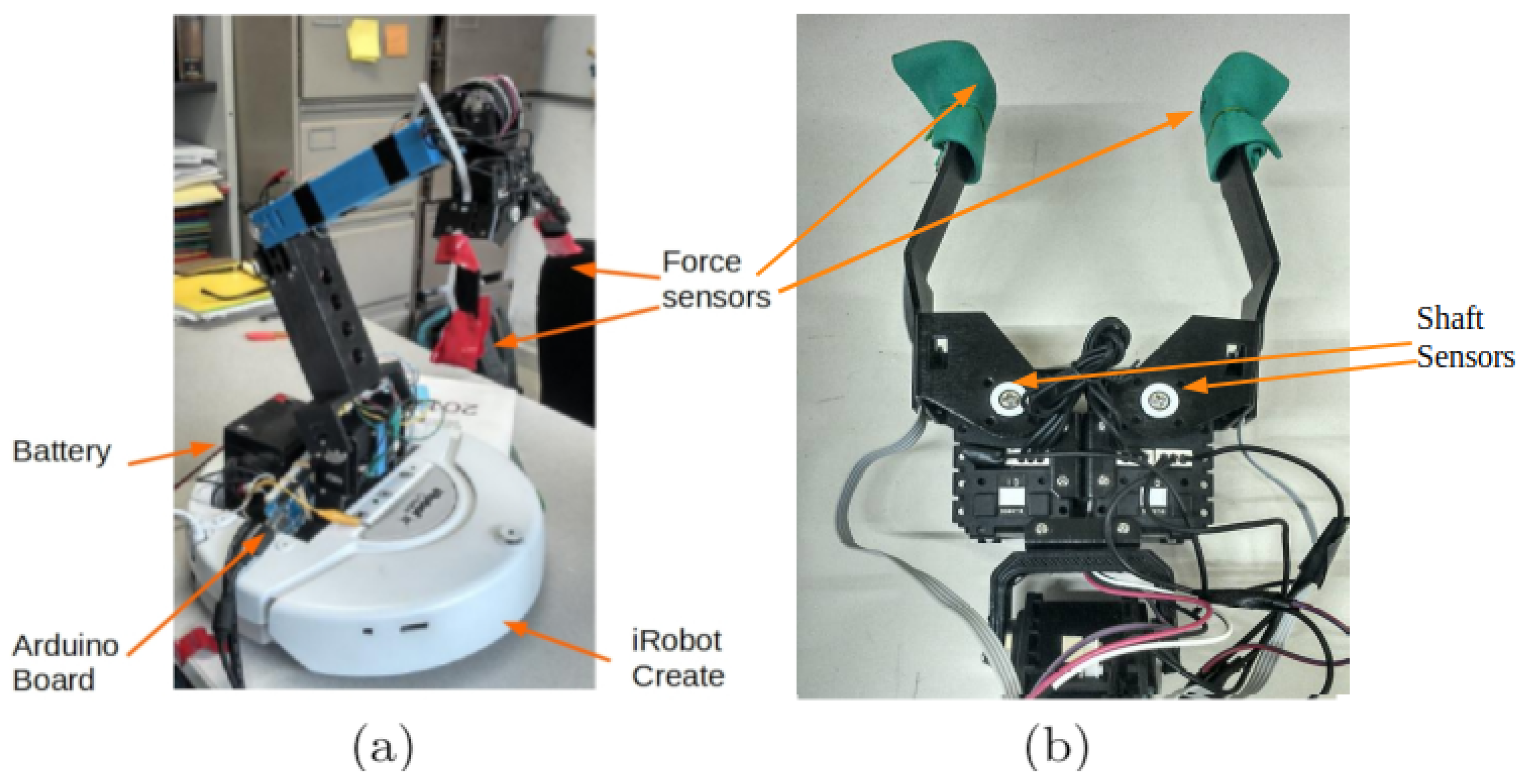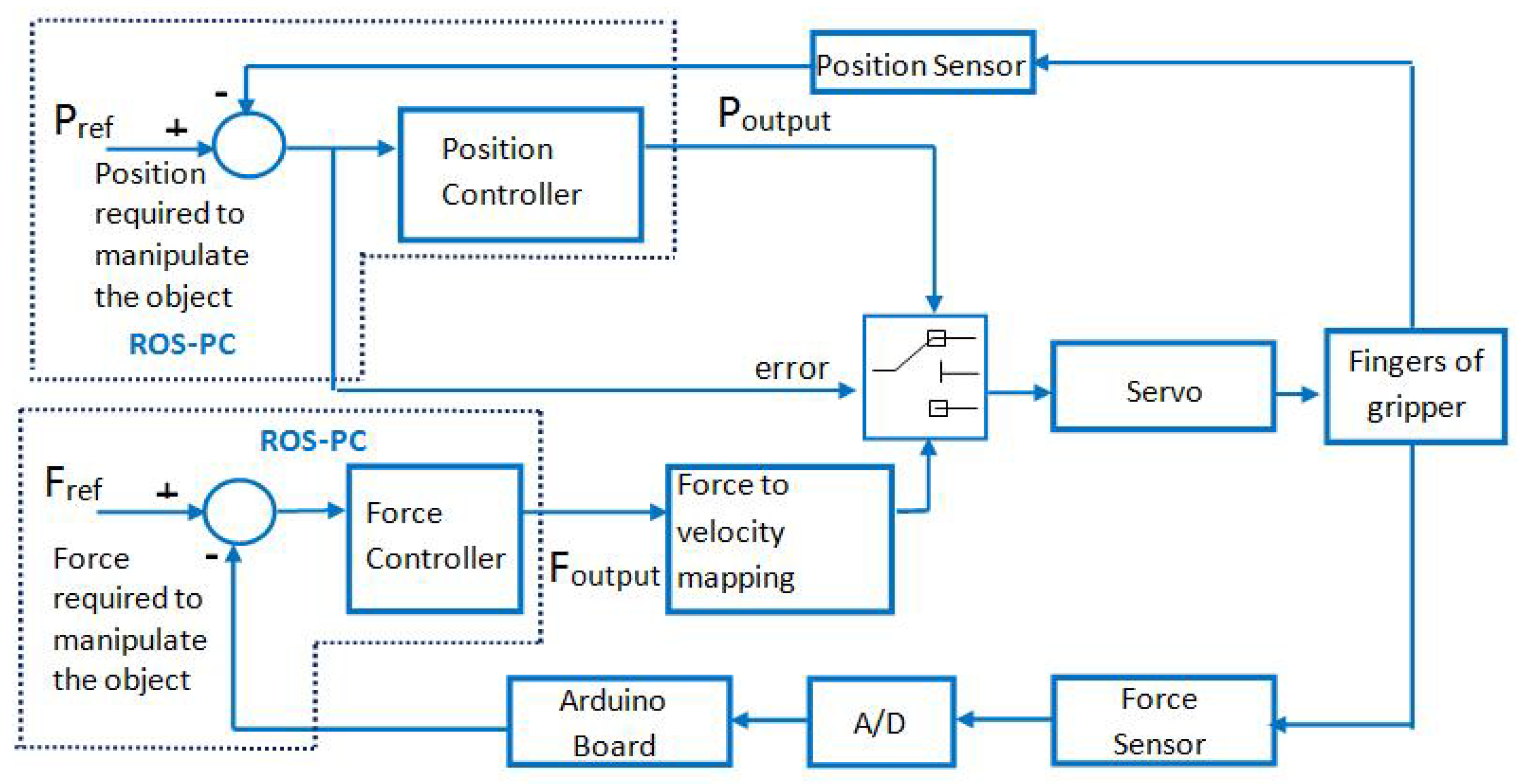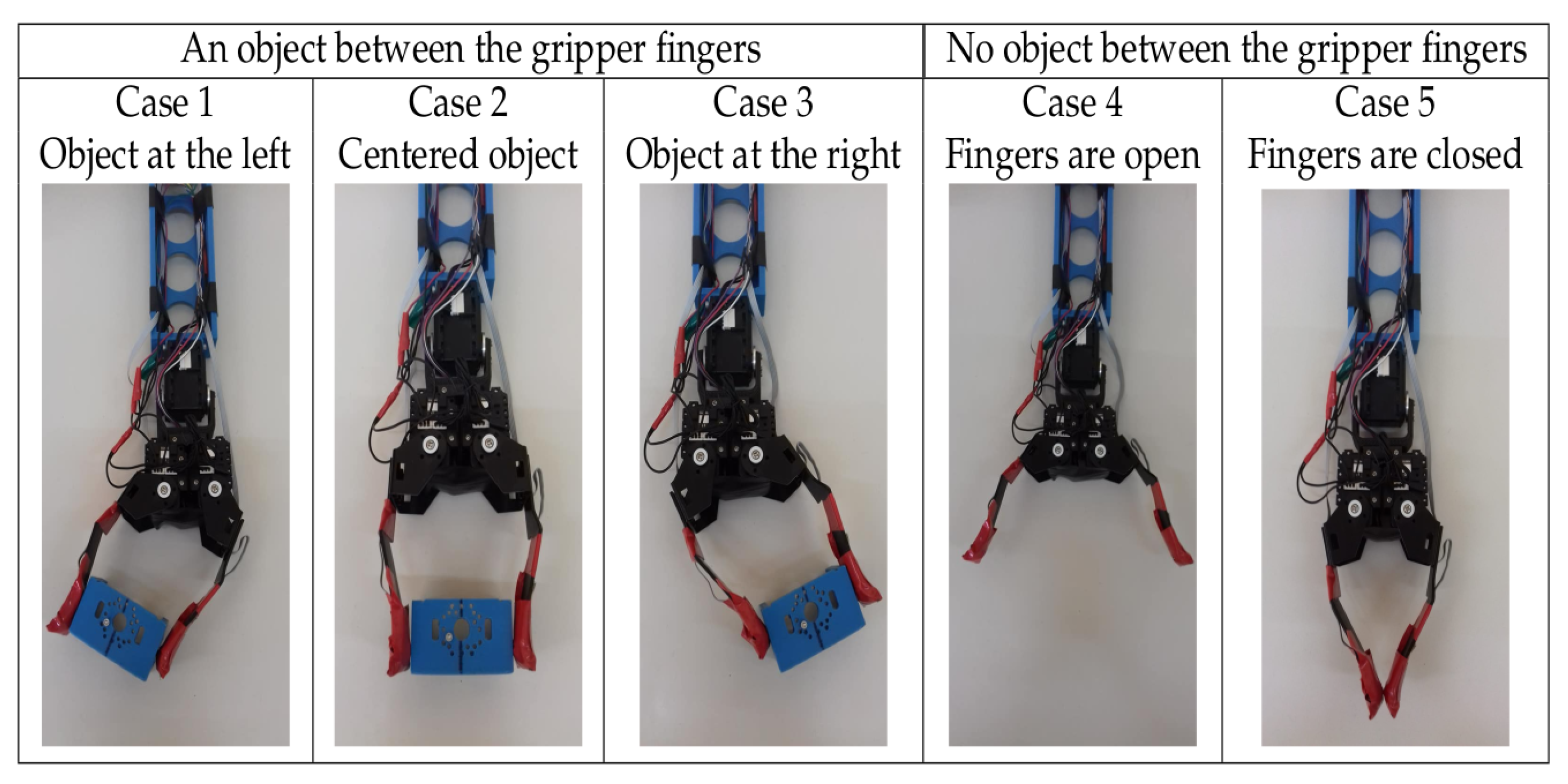Design and Implementation of Composed Position/Force Controllers for Object Manipulation
Abstract
:1. Introduction
2. Related Work
3. System Description: The Robotic Manipulator
- A two-independent-finger gripper. The gripper is composed of two Dynamixel AX-12 servo motors manufactured by CrustCrawler Robotics. Regarding the fingers, each finger is 10.16 cm long and is made of aluminum. Furthermore, they can be open up to 22.86 cm. An FFS-MT piezoelectric force sensor was placed at each fingertip (Figure 2b) The sensing force range for this sensor goes from 0 to 10 N, with an output resolution of 0.1 mV, providing a stable output over the range of force exerted. In addition, the output of this sensor exhibits linear behavior, as described in [36].
- A three-degrees-of-freedom arm. The arm is operated through Dynamixel servo motors. These servo motors each include a micro-controller, which obtains the different states of the servo motor (e.g., speed, position, temperature, and voltage). The maximum lifting capability is 900 g. A data acquisition board (Arduino) and a 12 V battery were placed on the back of the robotic arm (Figure 2a). The data acquisition board processes the signals from each force sensor and sends them to the computer.
- An iRobot Create. The robotic arm and gripper are mounted on an iRobot Create (mobile base). The iRobot allows moving the robotic arm from one place to another; therefore, objects may be repositioned.
4. Communication with an ROS
5. Grasping Stage
5.1. Problem Statement
5.2. Design and Implementation of the Controllers
5.3. Position–Force Hybrid PID Controller
5.3.1. Position Control
5.3.2. Force Control
5.4. Type-I and Type-II Fuzzy Controllers
5.4.1. Type-I Fuzzy Controller for Position and Force Control
- 1.
- Firstly, crisp values are obtained from each finger of the gripper. Specifically, angular positions (, ) and the two readings of force sensors ( ) of each finger are inputs to the fuzzy controller.
- 2.
- Secondly, these crisp values are translated into input-linguistic values using trapezoidal membership functions. This stage is called fuzzification.
- 3.
- Thirdly, rules are evaluated to compute the output-linguistic values. This process is called fuzzy inference.
- 4.
- Finally, the output-linguistic values are translated into two crisp values— and , which are the speed values for the right and left servo motors using a defuzzification method.
5.4.2. Type-II Fuzzy Controller for Position and Force Control
- 1.
- Firstly, the lower left motor () is computed in the following manner:
- (a)
- is sorted in ascending order, where is the lower left motor.
- (b)
- is computed aswhere and are the firing intervals. Let .
- (c)
- Find S, such that .
- (d)
- Find with for and for . Let .
- (e)
- If , go to step 6. If , set , and stop.
- (f)
- Let and go to step 3.
- 2.
- Secondly, the upper left motor () is calculated using the previous steps; but and U instances are used instead of and L instances.
- 3.
- Finally, the defuzzification process is performed; i.e., the average of and is computed to be used as the crisp value for the left motor ():
6. Results and Discussion
- Stage 1. The main goal of this stage is to center the object with respect to the center of the gripper. Assuming that the position of the object is known, the gripper starts approaching the object. Once the gripper has touched the object, it proceeds to position the object according to its center (the center of the gripper). This stage is known as “positioning” (Figure 11a–e).
- Stage 2. Once the object has been centered according to the gripper, the fingers apply specific forces grasp firmly the object; consequently, the object is less vulnerable to falling. As soon as the object has been grabbed, the base of the robot begins rotating for 4.6 s, which is sufficient time for the base to rotate approximately 180 degrees. At this stage, the force PID, type-I, and type-II have to regulate the force to be applied. This stage is known as “force” (Figure 11f–j).
- Stage 3. Finally, once the base of the robot has stopped, the arm moves down so that the gripper can release and position the object on the table (Figure 11k,l).
7. Conclusions
Author Contributions
Funding
Conflicts of Interest
References
- Miller, A.T.; Knoop, S.; Christensen, H.I.; Allen, P.K. Automatic grasp planning using shape primitives. In Proceedings of the IEEE International Conference on Robotics and Automation—ICRA’03, Taipei, Taiwan, 14–19 September 2003; Volume 2, pp. 1824–1829. [Google Scholar]
- Berenson, D.; Diankov, R.; Nishiwaki, K.; Kagami, S.; Kuffner, J. Grasp planning in complex scenes. In Proceedings of the 2007 7th IEEE-RAS International Conference on Humanoid Robots, Pittsburgh, PA, USA, 29 November–1 December 2007; pp. 42–48. [Google Scholar]
- Hasegawa, T.; Murakami, K.; Matsuoka, T. Grasp planning for precision manipulation by multifingered robotic hand. In Proceedings of the 1999 IEEE International Conference on Systems, Man, and Cybernetics—SMC’99, Tokyo, Japan, 12–15 October 1999; Volume 6, pp. 762–767. [Google Scholar]
- Bley, F.; Schmirgel, V.; Kraiss, K.F. Mobile manipulation based on generic object knowledge. In Proceedings of the 15th IEEE International Symposium on Robot and Human Interactive Communication—ROMAN 2006, Hatfield, UK, 6–8 September 2006; pp. 411–416. [Google Scholar]
- Kappler, D.; Chang, L.; Przybylski, M.; Pollard, N.; Asfour, T.; Dillmann, R. Representation of pre-grasp strategies for object manipulation. In Proceedings of the 2010 10th IEEE-RAS International Conference on Humanoid Robots (Humanoids), Nashville, TN, USA, 6–8 December 2010; pp. 617–624. [Google Scholar]
- Sanchez-Lopez, J.R.; Marin-Hernandez, A.; Palacios-Hernandez, E.R.; Rios-Figueroa, H.V.; Marin-Urias, L.F. A Real-time 3D Pose Based Visual Servoing Implementation for an Autonomous Mobile Robot Manipulator. Procedia Technol. 2013, 7, 416–423. [Google Scholar] [CrossRef] [Green Version]
- Tai, K.; El-Sayed, A.R.; Shahriari, M.; Biglarbegian, M.; Mahmud, S. State of the Art Robotic Grippers and Applications. Robotics 2016, 5, 11. [Google Scholar] [CrossRef] [Green Version]
- Khurshid, A.; Ghafoor, A.; Malik, M.A. Robotic Grasping and Fine Manipulation Using Soft Fingertip; IntechOpen: London, UK, 2011. [Google Scholar]
- Nee, A.Y. Handbook of Manufacturing Engineering and Technology; Springer: London, UK, 2015. [Google Scholar]
- Ang, K.H.; Chong, G.; Li, Y. PID control system analysis, design, and technology. IEEE Trans. Control Syst. Technol. 2005, 13, 559–576. [Google Scholar]
- Ang, K.H.; Li, Y. Survey on PID Control System Design and Tuning Software Tools. In Proceedings of the 5th Asia-Pacific Conference On Control and Measurement, Dali, China, 8–12 July 2002; pp. 12–17. [Google Scholar]
- Bhagwan, S.; Anil Kumar, J.S.S. A Review on: PID Controlle. Int. J. Recent Technol. Mech. Electr. Eng. (IJRMEE) 2016, 3, 17–22. [Google Scholar]
- O’Dwyer, A. Handbook of PI and PID Controller Tuning Rules; World Scientific: Singapore, 2009. [Google Scholar]
- Das, S.; Guha, D.; Dutta, B. Medical diagnosis with the aid of using fuzzy logic and intuitionistic fuzzy logic. Appl. Intell. 2016, 45, 850–867. [Google Scholar] [CrossRef]
- Lee, Z.J. A robust learning algorithm based on support vector regression and robust fuzzy cerebellar model articulation controller. Appl. Intell. 2008, 29, 47–55. [Google Scholar] [CrossRef]
- Zadeh, L.A. Fuzzy sets. Inf. Control 1965, 8, 338–353. [Google Scholar] [CrossRef] [Green Version]
- Hayward, G.; Davidson, V. Fuzzy logic applications. Analyst 2003, 128, 1304–1306. [Google Scholar] [CrossRef]
- Yager, R.R.; Zadeh, L.A. An Introduction to Fuzzy Logic Applications in Intelligent Systems; Springer Science & Business Media: New York, NY, USA, 2012; Volume 165. [Google Scholar]
- Lee, C.S.; Wang, M.H.; Hsu, C.Y.; Chen, Z.W. Type-2 fuzzy set and fuzzy ontology for diet application. In Advances in Type-2 Fuzzy Sets and Systems; Springer: New York, NY, USA, 2013; pp. 237–256. [Google Scholar]
- Son, C. Similarity measuring strategy of image patterns based on fuzzy entropy and energy variations in intelligent robot’s manipulative task. Appl. Intell. 2013, 38, 131–145. [Google Scholar] [CrossRef]
- Singh, S.; Garg, H. Distance measures between type-2 intuitionistic fuzzy sets and their application to multicriteria decision-making process. Appl. Intell. 2017, 46, 788–799. [Google Scholar] [CrossRef]
- Wang, L.; Liu, Z.; Chen, C.P.; Zhang, Y. Interval type-2 fuzzy weighted support vector machine learning for energy efficient biped walking. Appl. Intell. 2014, 40, 453–463. [Google Scholar] [CrossRef]
- Ali, F.; Kim, E.K.; Kim, Y.G. Type-2 fuzzy ontology-based opinion mining and information extraction: A proposal to automate the hotel reservation system. Appl. Intell. 2015, 42, 481–500. [Google Scholar] [CrossRef]
- Wang, X.; Fan, X.; Zhao, Y.; Ma, S. Parallel force control for a robot gripper based on grey prediction models. In Proceedings of the 2012 Power Engineering and Automation Conference, Wuhan, China, 18–20 September 2012; pp. 1–5. [Google Scholar] [CrossRef]
- Xie, Y.; Zhang, B.; Zhou, J.; Bai, Y.; Zhang, M. An Integrated Multi-Sensor Network for Adaptive Grasping of Fragile Fruits: Design and Feasibility Tests. Sensors 2020, 20, 4973. [Google Scholar] [CrossRef] [PubMed]
- Pastor, F.; Gandarias, J.M.; García-Cerezo, A.J.; Gómez-de Gabriel, J.M. Using 3D Convolutional Neural Networks for Tactile Object Recognition with Robotic Palpation. Sensors 2019, 19, 5356. [Google Scholar] [CrossRef] [PubMed] [Green Version]
- Costanzo, M.; De Maria, G.; Natale, C.; Pirozzi, S. Design and Calibration of a Force/Tactile Sensor for Dexterous Manipulation. Sensors 2019, 19, 966. [Google Scholar] [CrossRef] [Green Version]
- Widhiada, W.; Nindhia, T.; Budiarsa, N. Robust Control for the Motion Five Fingered Robot Gripper. Int. J. Mech. Eng. Robot. Res. 2015, 4, 226. [Google Scholar] [CrossRef]
- Ha, X.V.; Ha, C.; Nguyen, D.K. A general contact force analysis of an under-actuated finger in robot hand grasping. Int. J. Adv. Robot. Syst. 2016, 13, 14. [Google Scholar] [CrossRef] [Green Version]
- Ahmad, H.; Razali, S.; Mohamed, M.R. Fuzzy Logic Controller Design for A Robot Grasping System with Different Membership Functions. IOP Conf. Ser. Mater. Sci. Eng. 2013, 53, 012051. [Google Scholar] [CrossRef] [Green Version]
- Boughdiri, R.; Bezine, H.; Alimi, A.M. Fuzzy logic control for grasping 3d objects with sliding contacts. In Proceedings of the International Conference on Control, Engineering and Information Technology, Sousse, Tunisia, 4–7 June 2013; Volume 2, pp. 116–119. [Google Scholar]
- Dimeas, F.; Sako, D.V.; Moulianitis, V.C.; Aspragathos, N.A. Design and fuzzy control of a robotic gripper for efficient strawberry harvesting. Robotica 2015, 33, 1085–1098. [Google Scholar] [CrossRef]
- Su, K.H.; Huang, S.J.; Yang, C.Y. Development of robotic grasping gripper based on smart fuzzy controller. Int. J. Fuzzy Syst. 2015, 17, 595–608. [Google Scholar] [CrossRef]
- Ciobanu, V.; Popescu, N. Tactile controller using fuzzy logic for robot inhand manipulation. In Proceedings of the 2015 19th International Conference on System Theory, Control and Computing (ICSTCC), Cheile Gradistei, Romania, 14–16 October 2015; pp. 435–440. [Google Scholar]
- Jamil, M.F.A.; Jalani, J.; Ahmad, A. A new approach of active compliance control via fuzzy logic control for multifingered robot hand. Proc. SPIE 2016, 10011, 1001111. [Google Scholar] [CrossRef]
- Hernandez-Mendez, S.; Marin-Hernandez, A.; Palacios-Hernandez, E.R.; Vazquez-Leal, H. Characterization of two force sensors to be used in a robotic hand. In Proceedings of the 2015 International Conference on Electronics, Communications and Computers (CONIELECOMP), Cholula, Mexico, 25–27 February 2015; pp. 155–160. [Google Scholar]
- Johansson, R.; Westling, G. Roles of glabrous skin receptors and sensorimotor memory in automatic control of precision grip when lifting rougher or more slippery objects. Exp. Brain Res. 1984, 56, 550–564. [Google Scholar] [CrossRef] [PubMed]
- Horikawa, S.I.; Furuhashi, T.; Uchikawa, Y. On fuzzy modeling using fuzzy neural networks with the back-propagation algorithm. IEEE Trans. Neural Netw. 1992, 3, 801–806. [Google Scholar] [CrossRef] [PubMed]
- Wang, L.X.; Mendel, J.M. Fuzzy basis functions, universal approximation, and orthogonal least-squares learning. IEEE Trans. Neural Netw. 1992, 3, 807–814. [Google Scholar] [CrossRef] [Green Version]
- Hagras, H. Type-2 FLCs: A new generation of fuzzy controllers. IEEE Comput. Intell. Mag. 2007, 2, 30–43. [Google Scholar] [CrossRef]
- Karnik, N.N.; Mendel, J.M. Centroid of a type-2 fuzzy set. Inf. Sci. 2001, 132, 195–220. [Google Scholar] [CrossRef]
- Mendel, J.M. Uncertain Rule-Based Fuzzy Logic Systems: Introduction and New Directions; Prentice Hall PTR: Upper Saddle River, NJ, USA, 2001. [Google Scholar]












| IF | Operator | Operator | Operator | THEN | , | ||||
|---|---|---|---|---|---|---|---|---|---|
| 1 | AND | AND | AND | THEN | , | ||||
| 2 | AND | AND | AND | THEN | , | ||||
| 3 | AND | AND | AND | THEN | , | ||||
| 4 | AND | AND | AND | THEN | , | ||||
| … | … | … | |||||||
| 25 | AND | AND | AND | THEN | , | ||||
| 26 | AND | AND | AND | THEN | , | ||||
| 27 | AND | AND | AND | THEN | , | ||||
| 28 | AND | AND | AND | THEN | , | ||||
| … | … | … | |||||||
| 47 | AND | AND | AND | THEN | , | ||||
| 48 | AND | AND | AND | THEN | , | ||||
| 49 | AND | AND | AND | THEN | , | ||||
| 50 | AND | AND | AND | THEN | , |
| IF | Operator | Operator | Operator | THEN | , () | ||||
|---|---|---|---|---|---|---|---|---|---|
| = | AND | AND | AND | THEN | = | ||||
| AND | AND | AND | = | ||||||
| … | … | ||||||||
| = | AND | AND | AND | THEN | = | ||||
| AND | AND | AND | = | ||||||
| … | … | ||||||||
| = | AND | AND | AND | THEN | = | ||||
| AND | AND | AND | = |
| Controller | Position MR | Position ML | Force SR | Force SL | |
|---|---|---|---|---|---|
| PID | 2.93 | 6.53 | 11 | 3.31 | |
| Fuzzy I | 3.009 | 3.000 | 3.00 | 3.00 | |
| Fuzzy II | 2.705 | 3.31 | 3.91 | 3.31 | |
| PID | 3.67 | 10.76 | 7.5 | 4.5 | |
| Fuzzy I | 3.31 | 3.5 | 3.3 | 4.2 | |
| Fuzzy II | 3.61 | 3.9 | 6 | 4.5 | |
| Setpoint | 3.4 rad | 1.8 rad | 60 mV | 60 mV | |
| Response | Overdamping | Overdamping | Overdamping | Overdamping |
| Controller | IAE | ITAE |
|---|---|---|
| Hybrid PID | 10,278.5 | 47,901.75 |
| Type-1FLC | 684 | 6366.08 |
| Type-2FLC | 4864.25 | 31,878.23 |
Publisher’s Note: MDPI stays neutral with regard to jurisdictional claims in published maps and institutional affiliations. |
© 2021 by the authors. Licensee MDPI, Basel, Switzerland. This article is an open access article distributed under the terms and conditions of the Creative Commons Attribution (CC BY) license (https://creativecommons.org/licenses/by/4.0/).
Share and Cite
Hernandez-Mendez, S.; Palacios-Hernandez, E.R.; Marin-Hernandez, A.; Rechy-Ramirez, E.J.; Vazquez-Leal, H. Design and Implementation of Composed Position/Force Controllers for Object Manipulation. Appl. Sci. 2021, 11, 9827. https://doi.org/10.3390/app11219827
Hernandez-Mendez S, Palacios-Hernandez ER, Marin-Hernandez A, Rechy-Ramirez EJ, Vazquez-Leal H. Design and Implementation of Composed Position/Force Controllers for Object Manipulation. Applied Sciences. 2021; 11(21):9827. https://doi.org/10.3390/app11219827
Chicago/Turabian StyleHernandez-Mendez, Sergio, Elvia Ruth Palacios-Hernandez, Antonio Marin-Hernandez, Ericka Janet Rechy-Ramirez, and Hector Vazquez-Leal. 2021. "Design and Implementation of Composed Position/Force Controllers for Object Manipulation" Applied Sciences 11, no. 21: 9827. https://doi.org/10.3390/app11219827







